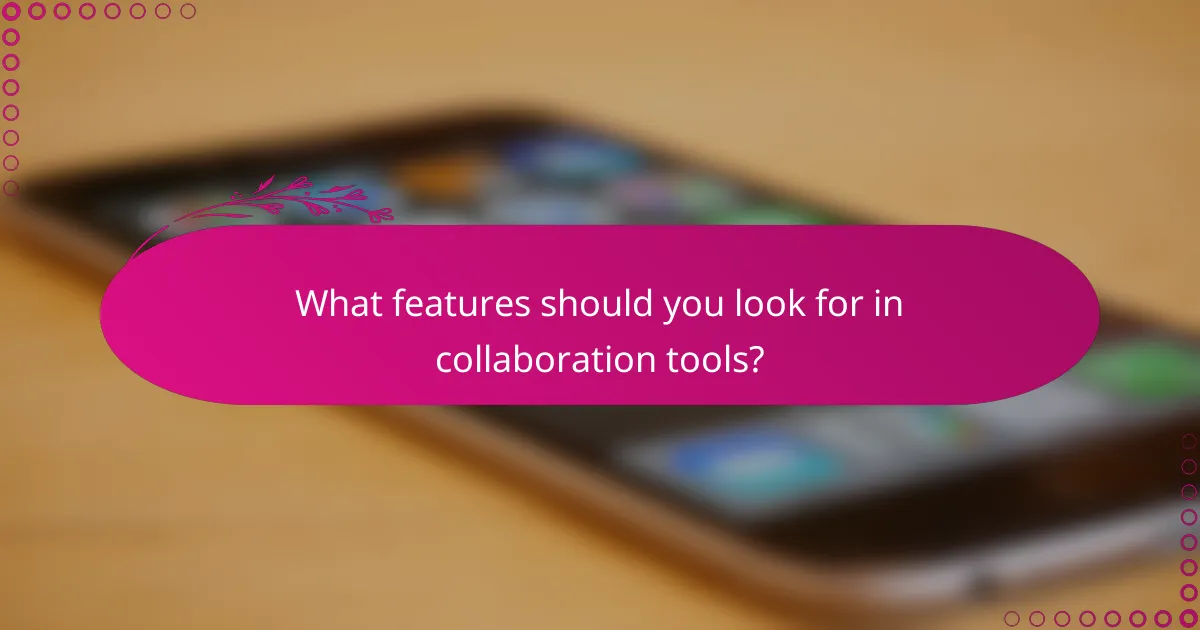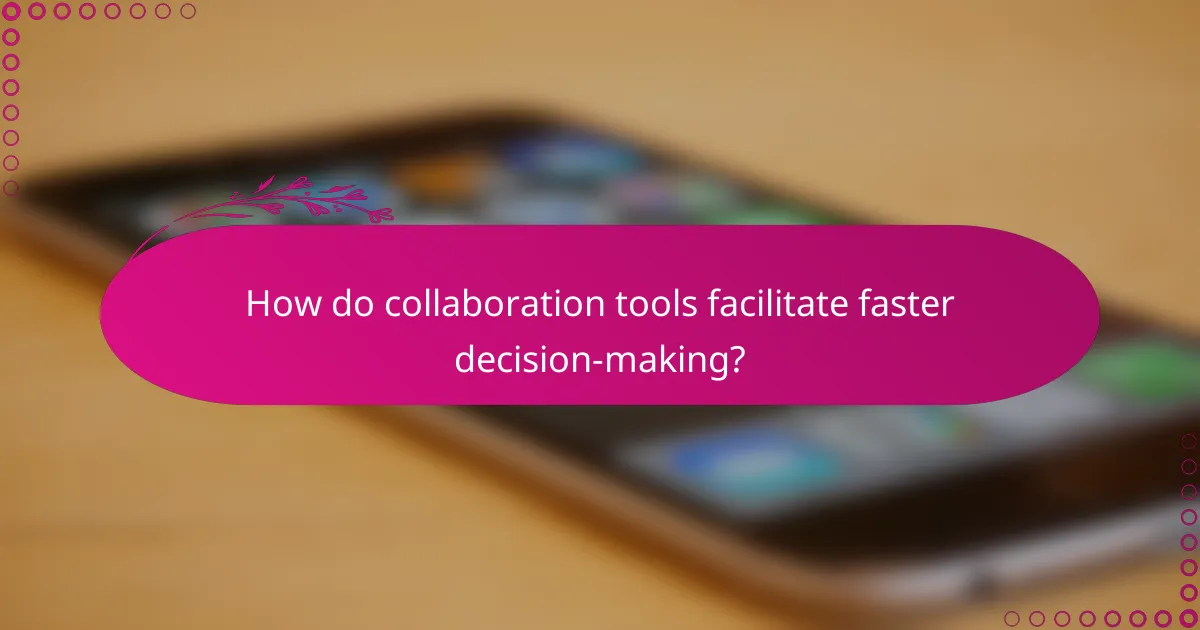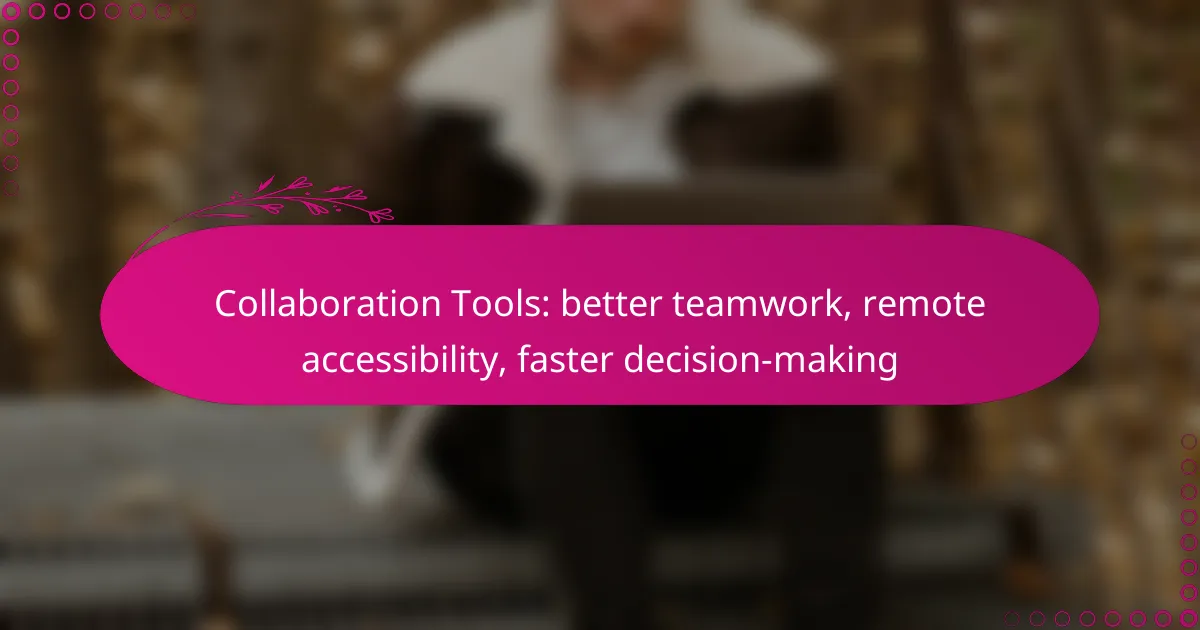Collaboration tools are essential for enhancing teamwork, especially in remote settings, by streamlining communication and project management. These tools enable teams to make quicker decisions and improve productivity through features like messaging, task tracking, and video conferencing. By prioritizing user-friendly interfaces and mobile accessibility, organizations can ensure effective collaboration regardless of location.

What are the best collaboration tools for remote teams in Australia?
The best collaboration tools for remote teams in Australia enhance communication, streamline project management, and facilitate quick decision-making. These tools cater to various needs, from messaging and task tracking to video conferencing, ensuring teams can work effectively regardless of their location.
Slack
Slack is a messaging platform designed for team communication, allowing users to create channels for different topics or projects. It supports file sharing, integrations with other tools, and direct messaging, making it a versatile choice for remote teams.
Consider using Slack for real-time discussions and quick updates, as it helps reduce email clutter. However, be mindful of notification overload; setting specific times for checking messages can improve focus.
Trello
Trello is a visual project management tool that uses boards, lists, and cards to organize tasks. Teams can easily track progress, assign responsibilities, and set deadlines, making it ideal for collaborative projects.
Utilize Trello’s features like checklists and due dates to keep tasks on track. A common pitfall is overcomplicating boards; keep them simple to maintain clarity and efficiency.
Microsoft Teams
Microsoft Teams combines chat, video conferencing, and file collaboration in one platform, making it suitable for remote teams needing an all-in-one solution. It integrates seamlessly with Microsoft 365 applications, enhancing productivity.
Leverage Teams for scheduled meetings and collaborative document editing. Ensure team members are trained on its features to maximize its potential and avoid confusion during use.
Asana
Asana is a task management tool that helps teams plan, organize, and track work. Its user-friendly interface allows for easy assignment of tasks, setting priorities, and monitoring deadlines.
Use Asana to break down larger projects into manageable tasks, ensuring everyone knows their responsibilities. Regularly updating task statuses can prevent bottlenecks and keep projects moving forward.
Zoom
Zoom is a video conferencing tool that enables remote teams to hold virtual meetings, webinars, and collaborative sessions. It offers features like screen sharing, breakout rooms, and recording options, making it a popular choice for remote work.
For effective meetings, set clear agendas and time limits to keep discussions focused. Be aware of potential technical issues; testing equipment beforehand can help ensure a smooth experience for all participants.

How do collaboration tools improve teamwork?
Collaboration tools enhance teamwork by facilitating seamless communication, enabling centralized project management, and providing avenues for real-time feedback. These tools help teams work together more efficiently, especially in remote settings, leading to quicker decision-making and improved productivity.
Enhanced communication
Effective communication is crucial for successful teamwork, and collaboration tools streamline this process. Features like instant messaging, video conferencing, and discussion boards allow team members to connect easily, regardless of their location. This reduces misunderstandings and fosters a culture of transparency.
To maximize communication, choose tools that integrate well with existing workflows and offer user-friendly interfaces. Regularly scheduled virtual meetings can also help maintain clarity and alignment among team members.
Centralized project management
Collaboration tools provide a centralized platform for managing projects, which helps teams stay organized and focused. By using task management features, teams can assign responsibilities, set deadlines, and track progress in real time. This visibility ensures everyone is aware of their roles and the project’s status.
When selecting a project management tool, consider features like Gantt charts or Kanban boards that visually represent tasks. Regular updates and check-ins can help keep the project on track and address any potential issues early.
Real-time feedback
Real-time feedback is essential for continuous improvement and quick adjustments in teamwork. Collaboration tools enable team members to provide and receive feedback instantly, whether through comments on shared documents or during live discussions. This immediacy helps teams refine their work and make informed decisions faster.
Encourage a culture of constructive feedback by establishing guidelines on how to give and receive input. Utilizing tools that allow for easy version control can also help track changes and ensure that everyone is on the same page regarding updates and revisions.

What features should you look for in collaboration tools?
When selecting collaboration tools, prioritize features that enhance teamwork, facilitate remote accessibility, and enable faster decision-making. Key aspects include integration capabilities, user-friendly interfaces, and mobile accessibility, which collectively improve the overall efficiency of team interactions.
Integration capabilities
Integration capabilities allow collaboration tools to connect seamlessly with other software applications, enhancing workflow efficiency. Look for tools that can integrate with project management platforms, communication apps, and file storage services to streamline processes.
Common integrations include linking with tools like Slack, Trello, or Google Drive. This connectivity ensures that team members can access all necessary resources without switching between multiple applications, saving time and reducing errors.
User-friendly interface
A user-friendly interface is crucial for encouraging team adoption and minimizing the learning curve. Tools should have intuitive navigation, clear icons, and straightforward functionalities that allow users to focus on collaboration rather than figuring out how to use the software.
Consider platforms that offer customizable dashboards and easy access to frequently used features. A well-designed interface can significantly enhance user satisfaction and productivity, making it easier for teams to collaborate effectively.
Mobile accessibility
Mobile accessibility ensures that team members can collaborate from anywhere, which is essential for remote work. Look for tools that offer robust mobile applications, allowing users to communicate, share files, and manage tasks on the go.
Effective mobile collaboration tools should maintain functionality similar to their desktop counterparts, enabling real-time updates and notifications. This flexibility helps teams stay connected and responsive, regardless of their physical location.

How do collaboration tools facilitate faster decision-making?
Collaboration tools enhance faster decision-making by streamlining communication and providing real-time access to information. These platforms allow teams to connect instantly, share insights, and make informed choices without unnecessary delays.
Instant messaging
Instant messaging platforms enable team members to communicate in real-time, reducing the time spent waiting for email responses or scheduling meetings. This immediacy allows for quick clarifications and rapid exchanges of ideas, which can significantly speed up decision-making processes.
For effective use, establish guidelines for when to use messaging versus other communication methods. Avoid overwhelming team members with constant notifications by setting “do not disturb” periods during critical work hours.
Shared document editing
Shared document editing tools allow multiple users to collaborate on the same file simultaneously, fostering a more dynamic and interactive decision-making environment. Changes can be made in real-time, and team members can see updates instantly, which helps in aligning thoughts and strategies quickly.
To maximize efficiency, use version control features to track changes and revert to previous versions if necessary. Encourage team members to leave comments for clarity and to facilitate discussions directly within the document.
Task assignment
Task assignment features in collaboration tools help clarify responsibilities and deadlines, ensuring that everyone knows their role in the decision-making process. By clearly defining tasks, teams can prioritize work and avoid duplication of efforts, leading to quicker resolutions.
Utilize visual project management boards to keep track of tasks and their statuses. Regularly review assignments in team meetings to adjust priorities and address any roadblocks that may hinder progress.

What are the pricing models for popular collaboration tools?
Collaboration tools typically offer various pricing models, including subscription-based, one-time purchase, and freemium options. Understanding these models helps organizations choose the right tool based on their budget and needs.
Subscription-based pricing
Subscription-based pricing is the most common model for collaboration tools, where users pay a recurring fee, often monthly or annually. This model usually includes regular updates, customer support, and cloud storage. Prices can range from a few dollars per user per month for basic plans to higher amounts for premium features.
For example, tools like Slack and Microsoft Teams offer tiered subscription plans that cater to different team sizes and feature requirements. Organizations should evaluate their specific needs and usage patterns to select the most cost-effective plan.
One-time purchase pricing
Some collaboration tools offer a one-time purchase option, allowing users to buy the software outright. This model is less common but can be beneficial for organizations that prefer to avoid ongoing fees. However, it may require additional costs for updates and support.
Examples include software like Microsoft Office, which can be purchased as a standalone product. Organizations should consider long-term costs, as one-time purchases may lead to higher expenses over time if updates are necessary.
Freemium pricing
Freemium pricing allows users to access basic features at no cost while offering premium features for a fee. This model is popular among startups and small teams, as it enables them to try the tool before committing financially. However, limitations on features and user capacity can be a drawback.
Tools like Trello and Zoom provide freemium models, allowing users to upgrade as their needs grow. Organizations should assess whether the free version meets their requirements or if they will need to invest in premium features later on.
